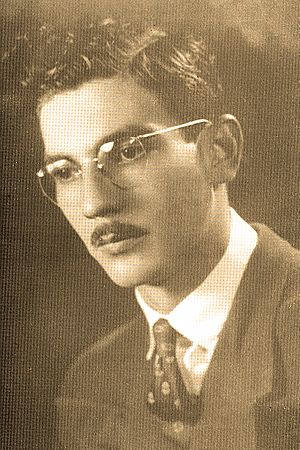Hugo Lindo facts for kids
Hugo Lindo Olivares (born October 13, 1917, in La Unión, El Salvador – died September 9, 1985, in San Salvador) was a famous Salvadoran writer, diplomat, politician, and lawyer. He was known for his poetry and stories, and also for representing his country in other nations.
About Hugo Lindo
Hugo Lindo was born in 1917 in La Unión, a port city in El Salvador. His family was middle-class. He went to the University of El Salvador. There, he earned a special degree in law and social sciences. In 1947, he started his career as a diplomat, traveling to Korea. A diplomat is someone who represents their country in other nations.
Lindo served as El Salvador's ambassador to different countries. He was the ambassador to Chile from 1952 to 1959. Then, he was the ambassador to Colombia from 1959 to 1960. In 1961, he became the Minister of Education in El Salvador. This meant he was in charge of the country's schools and learning. Later, he returned to being an ambassador, representing El Salvador in Spain from 1969 to 1972.
After his time as an ambassador, he opened a gallery and bookshop called “Altamar.” He had to close it later because of money problems in El Salvador. Hugo Lindo also helped start the Dr. José Matías Delgado University. He was the head of the university's Fine Arts department from 1979 until he passed away in 1985.
He was married to Carmen Fuentes and they had seven children. Two of his children also became well-known: Ricardo Lindo Fuentes became a writer, and Héctor Lindo Fuentes became a historian. Hugo Lindo died in San Salvador on September 9, 1985, when he was 68 years old. People still remember him today. In 2005, a special Reading Week in El Salvador was held in his honor. In 2010, the Dr. José Matías Delgado University celebrated 25 years since his death. Many of his books are still important readings in Salvadoran schools.
His Legal Writings
As a lawyer, Hugo Lindo wrote an important paper about divorce in El Salvador. This paper earned him a gold medal. He also wrote about how countries in Central America work together. His book, La Integración Centroamericana ante el Derecho Internacional (Central American Integration at the International Law), was published in 1971.
His Poetry
Hugo Lindo published many collections of poems. Some of his poetry books include:
- Poema eucarístico y otros (Eucharistic Poem and Others, 1943)
- Libro de Horas (Book of Hours, 1948)
- Sinfonía del Límite (Symphony of the Limit, 1953)
- Trece instantes (Thirteen Instances, 1959)
- Varia Poesía (Varied Poetry, 1961)
- Navigate río (River Navigator, 1963)
- Maneras de llover (Ways of Raining, 1969)
- Este Pequeño Siempre (This Small Always, 1971)
- Resonancia de Vivaldi (Resonance of Vivaldi, 1976)
- Aquí mi Tierra (Here is my Land, 1979)
- Fácil Palabra (Easy Word, 1985)
After he died, more of his poems were published. These included Desmesura (Disturbance, 1992), Prólogo a la Noche (Prologue to the Night, 1999), and Casi en la luz (Almost in the Light, 1999). A full collection of his poetry, called Mañana Será el Asombro (Tomorrow will be in Astonishment), was also published in three parts between 2006 and 2010.
His Stories
Hugo Lindo also wrote several well-known stories. His most famous work is El Anzuelo de Dios (God's Hook), which came out in 1956. Other stories he published include:
- ¡Justicia, Señor Gobernador! (Justice, Mr. Governor!, 1960)
- Cada día tiene su afán (Each Day has its Own Effort, 1965)
- Yo soy la Memoria (I am Memory, 1983)
See also
 In Spanish: Hugo Lindo para niños
In Spanish: Hugo Lindo para niños


